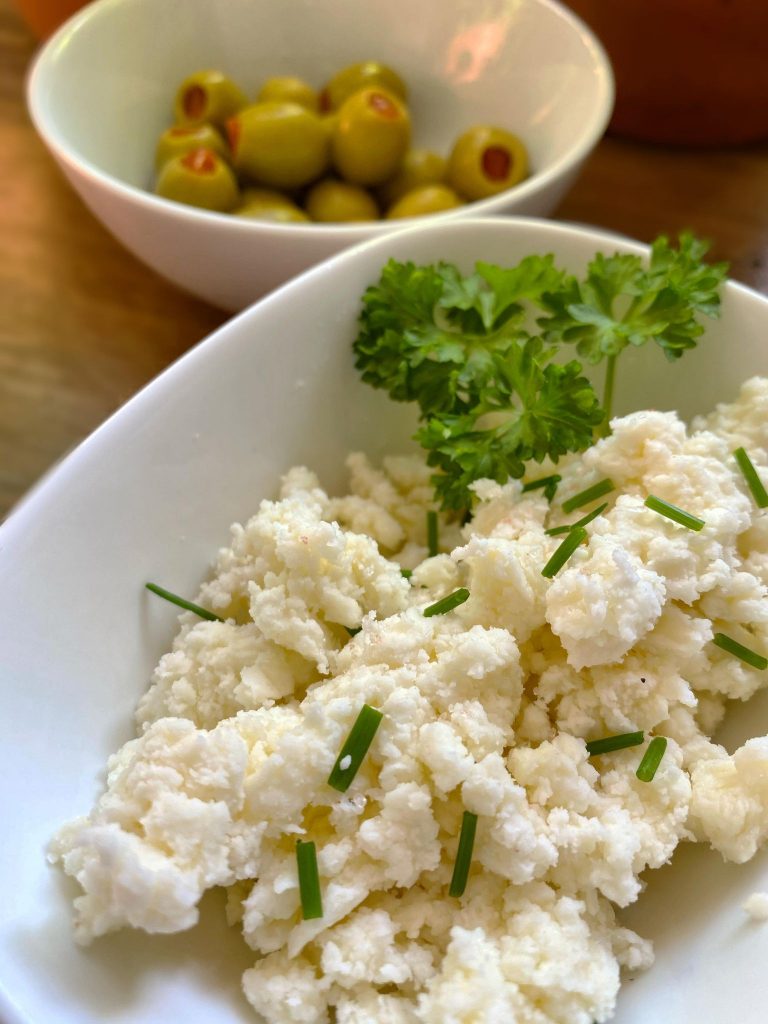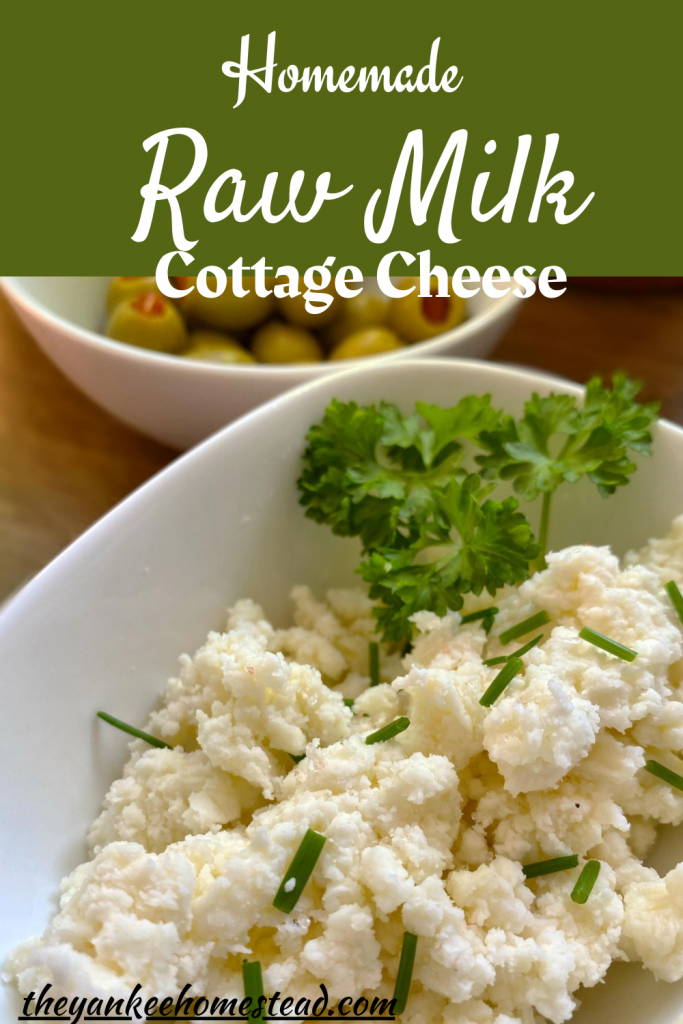This homemade raw milk cottage cheese is delicious and ridiculously easy to make! Plus, it can even be made with pasteurized milk. With just 4 common household ingredients and about 20 minutes of active working time, you’ll be enjoying fresh, healthy, full-fat cottage cheese in no time! And of course, without all the unnecessary ingredients you’d likely find in ordinary store-bought cottage cheese.
I grew up drinking raw goat’s milk and raw cow milk as a kid and feel very strongly about its safety and health benefits. My family raised milk goats for years, and eventually added several dairy cows to the farm as well. We often made our own mozzarella and homemade ice cream with our raw milk but not much more. Years past and my family had to sell out of our dairy cows and switched from dairy goats to show quality meat goats, but there was still many things I wanted to try making with raw milk.
Now as an adult, we drive about 1 1/2 hours one way a couple times a week to get our raw cow’s milk. That’s how good this stuff is. After drinking raw milk for so long I found it very hard to go to the thin, bright white liquid in the store that they try to pass off as milk. If pasteurized, fortified and homogenized “milk” from the store was my only option, I would completely eliminate milk from my diet.

What Is Raw Milk?
Raw milk is milk that has not been pasteurized through a heating and cooling process.
Raw milk can come from any animal, the most popular being dairy cattle, goats, sheep, yaks, and even camels!
Only about 1-3% of the population drinks raw milk.
What Is Homogenization?
Homogenization is the process of passing milk under high pressure through tiny holes which decreases the diameter and increases the number of surface area of the fat globules. This ensures that the molecules do not regroup and form a cream layer on top of the milk, which you do get with raw milk.
Testimonial From an Osteopathic Physician D.O. On Raw Milk and It’s Benefits.
Joseph Mercola, DO, osteopathic physician and author, in an Apr. 16, 2016 article for Mercola.com titled “Raw Milk and Cheese Are Undergoing a Renaissance as Artisanal Foods Rise in Popularity,” wrote:
“[Pasteurizing milk] destroys enzymes, diminishes vitamins, denatures fragile milk proteins, destroys vitamin B12 and vitamin B6, kills beneficial bacteria, and promotes the growth of pathogens.
Meanwhile, raw milk contains:
- Healthy bacteria that are beneficial for your gastrointestinal tract
- More than 60 digestive enzymes, growth factors, and immunoglobulins (antibodies). These enzymes are destroyed during pasteurization, making pasteurized milk harder to digest
- Phosphatase, an enzyme that aids and assists in the absorption of calcium in your bones…
- Beneficial raw fats, amino acids, and proteins in a highly bioavailable form, all 100 percent digestible
- Vitamins (A, B, C, D, E, and K) in highly bioavailable forms. Also has a balanced blend of minerals (calcium, magnesium, phosphorus, and iron) whose absorption is enhanced by live lactobacilli.”
Can I Use Pasteurized Milk?
Yes, pasteurized milk will work fine but I do recommend using whole milk, as 2% or nonfat will result in a very thin, liquidy cheese. Some people may want to stick to pasteurized milk for many different reasons, and that’s fine as well! No adjustments will need to be made to the recipe.
How Is Raw Milk Converted Into Cottage Cheese?
Cottage cheese is made by adding an acid (vinegar in this recipe) to raw or pasteurized milk (will not work for ultra-pasteurized milk) which then causes the milk solids to separate from the whey. Once the curds are formed, it is placed aside and allowed to continue draining. After that, it is gently separated using a spoon to break down and form the small cottage cheese curds.

Alright, let’s get started!
Equipment:
- Large pot
- Medium sized bowl
- Small sized bowl
- Colander
- 3/4 Measuring cup
- Teaspoon measuring spoon
- Tablespoon measuring spoon
- Slotted spoon (a spatula will also work)
- Cheesecloth or a clean kitchen towel
- Glass jar with lid
Ingredients:
- 1 Gallon of raw or pasteurized whole milk. (Don’t use ultra-pasteurized milk)
- 3/4 Cup of distilled white vinegar
- 1 Teaspoon of salt or to taste (Optional)
- 3 Tablespoons of cream (Optional) *See bottom of directions*
Directions:
Step 1: Start by rubbing an ice cube, or cold water for about 30 seconds on the inside bottom of your large pot. Next, pour in the gallon of raw milk and slowly heat to about 190°F/88 °C. Stir often so that the milk doesn’t scorch or burn to the bottom of the pan. Remove from heat and pour in the 3/4 cup of vinegar. Lightly stirring to incorporate. Do not over-stir. Cover and allow to sit for 30 minutes.
Step 2: Line the colander with doubled cheesecloth or a clean kitchen towel, and place over a medium sized bowl. Using your slotted spoon, scoop up all the solids out of the whey. (It won’t look like cottage cheese quite yet) Allow to drain for 20 minutes.
Step 3: Gather the ends of the cheesecloth together, forming a tight ball of cheese. Run the ball of cheese under cold water, gently squeezing and kneading until all the warm water from the cheese-ball runs out and it feels cool to the touch.
Step 4: Remove the cheese from the cloth and set inside a small bowl. Use a spoon to break into small curds. Add in the salt to taste. Transfer to a glass jar with a lid and store in fridge.
Chill for 1-2 hours before serving. Use within 1 week.
***If you like creamy cottage cheese, add in the extra cream. I recommend doing this 1 tablespoon at a time until it reaches a consistency you like.***

See My Other Raw Milk Recipes:
Ways To Enjoy Your Homemade Raw Milk Cottage Cheese
- On top of crackers or toasted bread
- Sprinkle homemade raw milk cottage cheese on a salad
- Add some into scrambled eggs
- Layer it into homemade lasagna or stuffed shells. I also like to sprinkle some into homemade spaghetti.
- Take mashed potatoes to the next level by adding in some homemade raw milk cottage cheese
- Make a raw milk cottage cheese and herb dip for your next gathering
Pin It!

Leave a Reply